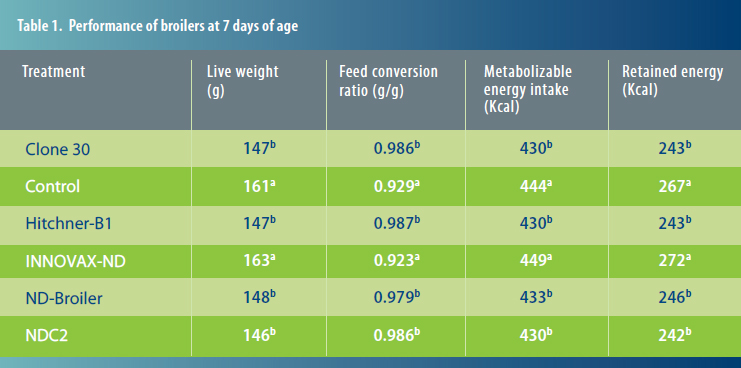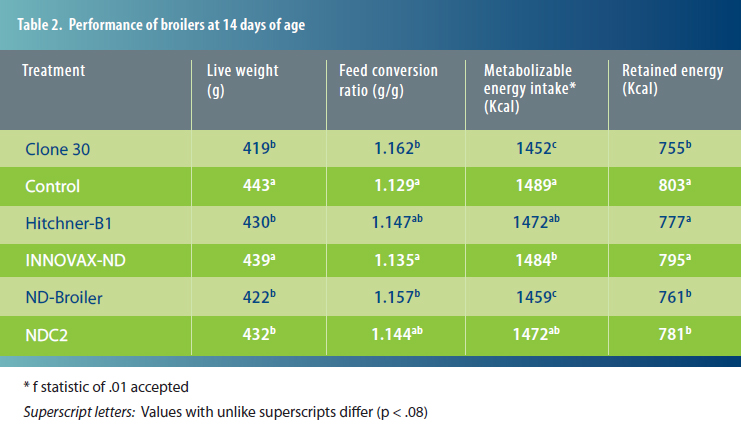
Broilers appear to perform better the first weeks of life if the Newcastle disease vaccine they receive is one that causes less stress, according to Robert Teeter, PhD, a consulting nutritionist formerly with Oklahoma State University, USA.
Today’s broiler operates only at about 50% efficiency, says Teeter, who has spent decades studying energy utilization in broilers at his lab, which is outfitted with 60 metabolic chambers.
“When we look at all sources of lost energy in the bird, we can project that 66% efficiency — and a feed conversion ratio of 1 — is possible,” Teeter says. Toward that end, “it’s critical that we understand the growth curve and the various types of stresses that come from the environment. We must also account for every calorie.”
Stress from vaccination
One stress to consider is vaccination. While vaccination is important to flock health, stimulating a bird’s natural immunity can cause some short-term stress. Field vaccination with conventional, live attenuated vaccines against Newcastle disease (ND) can result in different levels of post-vaccinal reactions, depending on the vaccine strain used as well as the route of administration. The reactions can reduce bird performance.
Consequently, Teeter studied the impact of five different vaccines for ND because it is one of the most important and costly diseases of poultry, with a near 100% mortality.
For his experiment, Teeter used commercial Cobb male broilers that had not been vaccinated. He compared five vaccines administered on day 1 of their arrival at the laboratory:
Subcutaneous
- INNOVAX-ND (recombinant vaccine)
- ND-Broiler (inactivated vaccine)
Eyedropper
- C2-strain (live vaccine)
- Hitchner B1 (live vaccine)
- NOBILIS ND Clone 30 (live vaccine)
A sixth group of birds remained unvaccinated to serve as a negative control.
‘Considerable’ difference
After the birds were vaccinated upon arrival at the lab, they were housed until 28 days of age in metabolic chambers, which enable measurement of energy metabolism. Investigators weighted birds weekly and monitored them continuously for carbon dioxide production and oxygen consumption. They also measured heat production and body composition.
“By day 7, the difference between the vaccine groups was considerable,” Teeter says.
Using the control group as a reference point, the pioneering nutritionist and his team determined that broilers receiving the recombinant vaccine — known for causing no reactions in birds — had significantly better weight gain and feed conversion. They also retained more energy compared to the other vaccine groups and had better values compared to other vaccine groups by day 14 (Tables 1 and 2).


Less heat production
At 7 and 14 days of age, the recombinant vaccine group also had significantly less heat production than those that received the other vaccines, as well as higher protein, fat and net energy values.
By 21 days, there was little difference among the vaccine groups. However, Teeter says, “Having a vaccine-reaction duration those first 2 weeks is the type of event that is cumulative with other aspects of performance. What other stressors will be added?”

Chicks were placed in metabolic chambers, which enable measurement of energy metabolism.
Heat stress is particularly important, according to Teeter, because it is associated with a worsening feed conversion, and that translates into lost income for producers, he says.
Teeter concludes that different ND vaccines affect growing broilers differently. “The first 2 weeks following vaccination appear to be critical for vaccination impact,” he adds, “and INNOVAX-ND had less impact than all the other vaccines, especially during those first 7 days.”
More Issues









